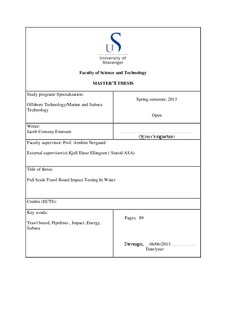Full scale trawl board impact testing in water
Master thesis
Permanent lenke
http://hdl.handle.net/11250/183044Utgivelsesdato
2013Metadata
Vis full innførselSamlinger
Sammendrag
During the last decades, the weights of trawl boards used in the North Sea, Norwegian Sea and the Barents Sea have increased significantly from barely a ton to a score of tons. In addition, the trawling speed has increased as well. These new faster and heavier trawl boards, in an event of impact with subsea structures, will result to tremendous loads on these structures. Impact with existing structures which were designed with recommendation from ISO 13628- part 1 may be devastating for the subsea structures as the new loads the structures will experience may be greater than its design loads.
Model trails performed in the late 80´s at a water depth of 100m, speed at 1,8 m/s and trawl board weight up to 1 900 kg resulted to an establishment of a design impact energy requirement of 13 kJ [9]. Statoil, in response to the increase in weight and velocity of trawl boards, raised their impact energy recommendation to 38 kJ.
This thesis aims at raising concerns on the level of conservatism in these values given that impact incidence that resulted to no damage at all on a subsea structure have been reported. It is worth mentioning that these structures were designed according to ISO 13628- part 1, but however the trawl board in this impact had a weight of 4 400 kg.
Statoil´s recommendation springs from impact test conducted in air and a theoretical study of the trawling situation for subsea structures from DNV report.
The following question arises: Is the Statoil´s recommended design impact energy of 38 kJ too conservative?
The goal of this work is to challenge this impact energy recommendation. This will be done by conducting a series of impact test on a copper pipe under the following configurations:
- An empty pipe will be impact tested in air.
- A closed pipe filled with water will be impact tested in air.
- A sealed water fill pipe will be impact tested in water.
The result from the following configurations will be analyzed and compared in order to determine the possible effect of damping (due to water in and out of the structure) on its response, laying ground work for a full scale test.
Beskrivelse
Master's thesis in Offshore technology
